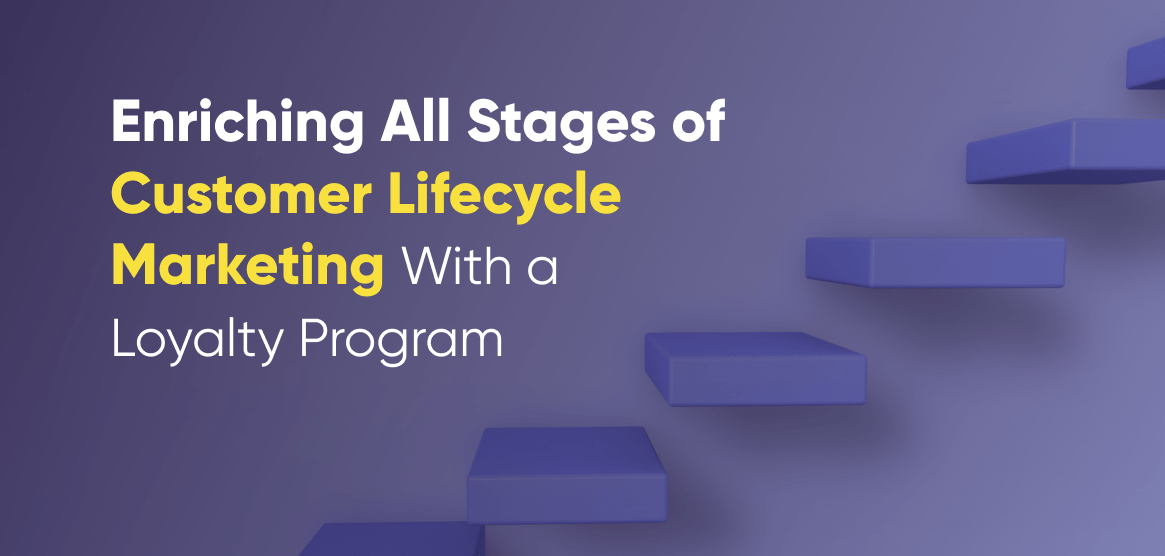It’s generally accepted that existing customers drive more value than new ones. Then why is it that the general customer retention rate is 20% or less? There are a number of factors. For instance, the Covid-19 pandemic has changed the customer reality forever. But more importantly, when it comes to customer retention (and loyalty programs), you can’t put all your eggs in one basket. In other words, don’t choose between retention and acquisition: pick both! That’s right, you should use your loyalty program to drive every part of your lifecycle marketing strategy.
What Is Lifecycle Marketing (or CLM)?
Lifecycle marketing—or customer lifecycle marketing—is a seamlessly integrated marketing strategy that aims to target, convert and retain shoppers throughout each stage of the customer journey.
In order to achieve the highest possible customer lifetime value, marketers need to lay out a well-crafted roadmap of touchpoints. The overall goal is to provide a quality shopping experience from the window-shopping stage to the point where people become brand advocates.
In order to achieve this, you have to categorize your customers first, so your lifecycle marketing strategy will accurately target them:
- Prospects – These are future customers who show interest in your brand. They can be anonymous website visitors, window shoppers, or even registered users.
- Active customers – These are “the” customers, who purchase your goods or services. They can be first-time buyers, returning customers (2-3 orders), or frequent buyers (3+ orders).
- Inactive customers – These are the customers who used to purchase from your store, but have stopped for some reason. They are at risk of churning and require proper motivation to stay with your brand.
- Engaged customers – These are customers who have successfully been reactivated. They are truly loyal, have a high lifetime value, and unlikely to churn.
What Are the Stages of Lifecycle Marketing?
Over the Internet, lifecycle marketing is depicted and described in a number of ways. Here’s what you need to know about the main stages:
- Stage 1: Reach & Acquire – At this point, customers know little to nothing about your brand, so you have to get their attention. This is where the “marketing” in “lifecycle marketing” shines brightest, as you can use a variety of ad campaigns to raise awareness. However, never underestimate the power of good ol’ word-of-mouth—you’ll soon see why.
- Stage 2: Act & Convince – Now customers know about you, and are considering a purchase. They usually need a little nudge, though. Reviews and recommendations from their peers, blogs, or even a first-purchase reward from a loyalty program can be convincing enough for these customers to choose your brand over the competition.
- Stage 3: Convert & Motivate – After sealing the deal for the first time, you have to think of ways to keep customers and push them towards their second or third purchase. Personalized newsletters, free shipping, a tiered loyalty program structure; all of these can be used to maintain interest over a prolonged period of time.
- Stage 4: Engage & Recognize – Some lifecycle marketing strategies stop around the third stage. However, modern customers tend to lose interest if a business only shows interest in promoting the next purchase. In order to encourage true loyalty (or even turn customers into brand advocates), organizations need to focus on non-transactional engagement.
Add Flavor to Your Lifecycle Marketing With a Loyalty Program
Since we rounded up the four stepping stones of lifecycle marketing, it’s time to see how a loyalty program can enrich the whole structure. Let’s use Tokyo Otaku Mode as an example to show how a well-implemented reward program can add value to each of the stages, and go even beyond…
Stage 1: Reach & Acquire
When it comes to piquing the interest of new customers, existing loyalty program members are your most valuable assets. So, for the first step of your loyalty-improved lifecycle marketing, incentivize friend referrals and product reviews to get positive word of mouth!
In this sense, Tokyo Otaku Mode relies on a tried-and-tested behavioral trick, called “The first one’s free”. Since the loyalty program is subscription-based, friends or family members can pre-purchase a loyalty currency bundle and gift it to their loved ones. Recipients then redeem the currency for benefits like free gifts, daily manga tickets, or extra tokens to win a prize in the crane-style minigame.
Stage 2: Act & Convince
In this phase of lifecycle marketing, leads are just browsing your site but aren’t yet members. Encourage them to become invested in the loyalty program by incentivizing soft actions, like gamified surveys, which provide valuable data that can be used for personalization.
Tokyo Otaku Mode highlights the benefits of loyalty membership the moment you look at the product. Below the price tag, customers see how much of a discount they would receive as a loyalty member. Moreover, unregistered visitors are reminded that opting for premium membership means they’ll get a $10 discount applied to their first purchase. And to sweeten the deal even more, the company throws in a 30-day free trial as well.
Stage 3: Convert & Motivate
This lifecycle marketing stage is the most straightforward, as most loyalty-related features, such as tiers or VIP clubs take effect at this point. Still, here’s a tip: let customers redeem their hard-earned points for something more meaningful than a discount or gift card.
Tokyo Otaku Mode falls a bit short in this case, as the company primarily focuses on price-related incentives. There’s a cashback bonus for both the premium subscription and the actual purchase, plus the promise of free shipping once overall order value reaches $150. In case you wish to truly stand out, think outside of the box! Come up with reward ideas that are truly irresistible, like uniquely designed gifts, invitations to community events, or exclusive access to upcoming products.
Stage 4: Engage & Recognize
The concept of reactivating customers who are at risk of churning is fine on paper but how does it look in action? For a truly unique loyalty experience, consider implementing any of the following in your lifecycle marketing process:
- Exclusive content: Tokyo Otaku Mode not only allows premium members to read their officially licensed manga—something their community goes bonkers for—but they also provide insider access to staff happenings and secret events, which is a great way to build an emotional connection with the community.
- Gamification: Probably the craziest feature of Tokyo Otaku Mode is its crane-like minigame. Loyalty members receive free game tokens each day, and they can purchase tokens with points, too. And this isn’t a sweepstake: players have to actually use their skills in order to win.
- Surprise & Delight: Personalized birthday messages that come with bonus points are not only a nice gesture, but they also create a positive sensation. Recipients feel appreciated and are likely to make an unplanned purchase just to redeem their gift.
- Dedicated Loyalty App: Don’t forget about on-the-go engagement! A dedicated loyalty app conveniently hosts all the aforementioned features in a portable manner, while also providing a means to stay in touch with members through push notifications.
- Engagement outside of the buying cycle: In order to connect with inactive customers (people who bought from you, but have since lost interest), you should align with their values, and incentivize actions such as working out or recycling products.
A Successful Cycle Never Ends
Moving customers up through the lifecycle stages is a piece of cake with the right incentives. If you know how to keep your shoppers invested in all circumstances, they’ll never let you go. That’s why it’s truly a win-win to run a next-gen loyalty program. If you’d like to use Antavo’s world-class loyalty programs to power up your lifecycle marketing, then request a demo or include us in your loyalty program RFP.
Ready to start drafting your loyalty program ideas? Download our handy worksheet to get a head start!

